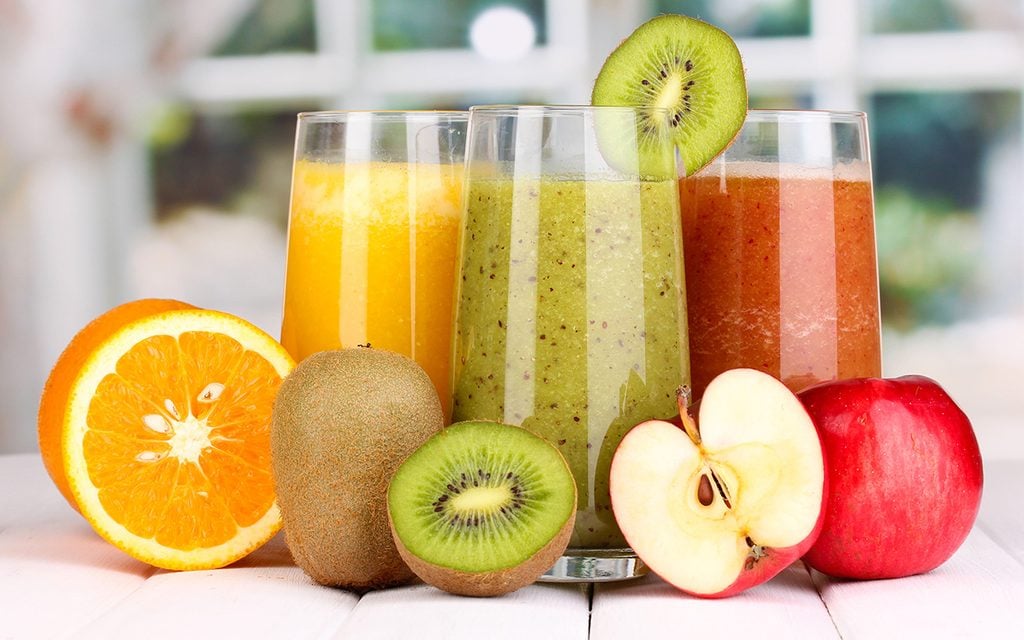How to Make Cold-Pressed Juice (With or Without a Juicer!)
Updated: Nov. 03, 2022

Buying a cold-pressed juice is tasty, but over time the habit can get expensive! Learn how to make cold-pressed juice at home, with or without a juicer.
Drinking juice is an excellent way to sneak a few extra fruits and vegetables into your diet. While the absolute healthiest way to consume produce is whole (a good excuse to whip up a tasty salad), cold-pressed juice is the next best thing. The process extracts the maximum amount of vitamins and minerals from your fruits and veggies, delivering it to your body in a tasty package.
If you’re on the juice train, you know how expensive it can get to buy it bottled day in and day out. It might be time to learn how to make cold-pressed juice—with or without a juicer! Psst! If you’re looking for a juicer, your best bet is the Magic Bullet mini juicer—it’s compact, affordable and efficient.
Is Cold-Pressed Juice Good for You?
Juice is full of vitamins, minerals and antioxidants, and cold-pressed juice has the added benefit of being made without the heat of a juicing machine. The juicing process separates the liquid components from its solid, fiber-filled casing. Traditional centrifugal juicer (like this one) use sharp blades to break vegetables down into a pulp. Then a motor spins at high speeds to release the juice inside. Those blades produce heat, which can destroy essential enzymes in the juice.
A cold press or masticating juice extractor, on the other hand, does the same thing by squeezing and crushing the pulp. Does that make cold pressed juice better than the alternative? For starters, it creates a more concentrated product, so you don’t need to drink as much of it. And because some vitamins and minerals are damaged by heat or lose their voracity as they’re exposed to oxygen in the centrifuge, cold-pressed juice is more nutrient dense, too.
How Many Veggies Go into a Cup of Juice?
It’s pretty impossible to have a standard answer to this question because each piece of produce creates a different amount of juice. Grapes, carrots, apples and beets can make about a cup of juice per pound of fruit, but spinach and lettuces may take closer to two pounds to create the same yield. You’d need four to eight bunches of parsley to get a full a cup!
Play around with your favorite superfood fruits and vegetables to see how much juice each one produces. If you make too much, you can always store the juice in a mason jar in the refrigerator.
How to Make Cold-Pressed Juice Without a Juicer
It’s surprisingly easy to make juice without a juicer! All you’ll need is a blender and your favorite fruits and vegetables. Keep in mind that the blender will produce a bit of heat as it purees your veggies, so you may want to use our juicer method below if you really want to get the maximum nutrients out of your produce.
Step 1: Chop your veggies
Select your favorite juicing vegetables—apples, carrots, leafy greens, beets, ginger or anything else that strikes your fancy. Give ’em a rough chop to help them break down in the blender. Anything from 1/2-inch to an inch in size should work just fine.
Step 2: Add water and blend
Add 1/2 to 1 cup of water, depending on how full you’ve filled the blender. You can always add more water, and it’s unlikely you’ll add too much water, so don’t sweat the amount too much. Start the motor and puree the vegetables until you don’t see any chunks in the blender. When everything looks pretty liquidy, your work here is done!
Step 3: Strain and enjoy
There will be a lot of pulp in your blender, which is good, edible fiber if you like. But, if you’re going for juice-cleanse-like juice, you’ll want to strain out the solids. A mesh strainer isn’t fine enough to get the job done, so we recommend lining it with cheesecloth or a clean pair of tights or stockings.
How to Make Cold Pressed Juice with a Juicer
For true, 100% cold-pressed juice, remember that you’ll want to invest in a masticating juicer instead of a centrifugal version. Either type makes delicious juice that’s super easy to make: Just drop your produce into the machine. Most of it doesn’t even need to be peeled or chopped (although you’ll want to refer to the owner’s manual to be sure).
Step 1: Select your veggies
Most juicers don’t require any chopping or peeling to get started. You may need to cut large items like carrots or apples in half to get them to fit into the hopper. To avoid damaging the machine, you may also want to remove tough peels on fruits like pineapple or citrus.
Step 2: Drop ’em in
Following the instructions that came with the juicer, turn on the machine, drop the veggies into the hopper and enjoy the fruits of your labor!
Next up: Infused water recipes that taste way better than water.
Note: Every product is independently selected by our editors. If you buy something through our links, we may earn an affiliate commission.
